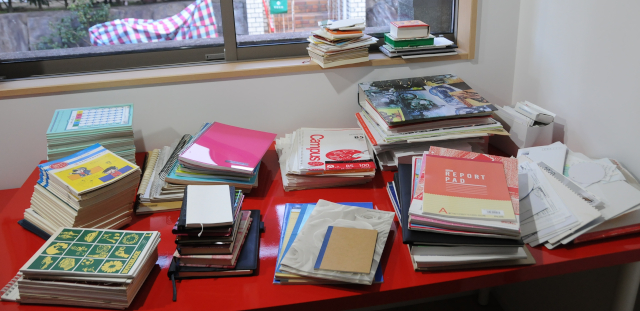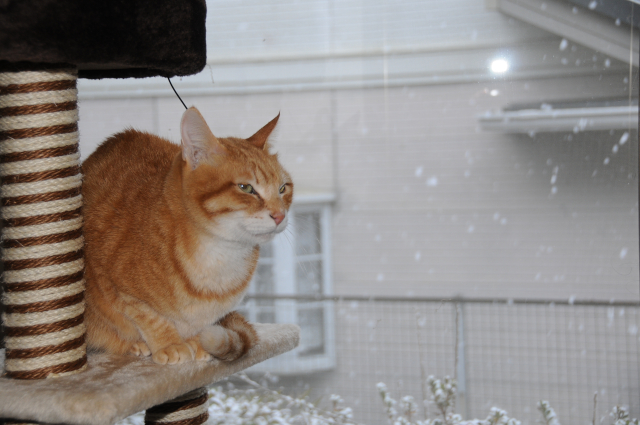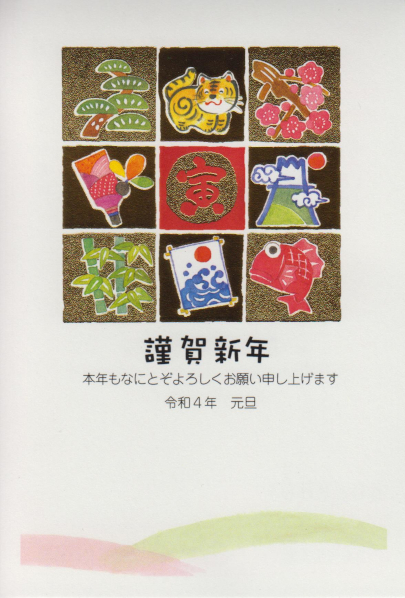Finally, as promised (too) long ago, here’s the photo diary of my office renovations. It was very interesting to watch my office change over the course of only 3 weeks, so let’s start with the “before” again:
As you can see, everything was dark and brown and rather… 70s I guess? Since I’m prone to depression, replacing all this drabness with light colors was a no-brainer. Also, the sliding doors to the outside gave me negative vibes. Even though this is a purely residential neighborhood with no through traffic, and outsiders scouting out houses would be easily noticed, I felt that the doors directly at the street were unsafe. Not that a window is any more secure if you think of it, but this is not about logics, really.
Day 1
The brown walls and the floor boards have been removed, showing the underside of both. The walls are a traditional timber frame with bamboo slats in the centre, and covered with mud and plaster at the outside (or wood panels). As you can see, the whole house rests on foundation stones – quite literally. As the building is not fixed to the underground, there is a certain flexibility during earthquakes. I remember an old farm house in an open-air museum, which jumped more than a meter during an earthquake and remained essentially intact. Still, when I saw this, I understood why my architect called the house “not very safe – at least not for modern standards”.
Day 2+3
Two more days and the floor is back. So is additional wood framing that will carry the new walls. It looks all very neat and pleasant – and yet, I was not happy when I saw this… The wall at the left also has new wood framing, when instead I wanted it removed completely. Behind this wall lies the staircase, which has a large storage area underneath, and I wanted to access this storage from the office.
Additional tools and parts were stored in the garage from the beginning, including the window. Unfortunately, I didn’t notice until that day that the window was not high enough – around 46 cm of glass only – so that was one more thing to complain about to the contractor. On the positive side, the electric cables for the new lights and electric socket had been installed already.
Day 4
The contractor came very early in the morning, and we negotiated the storage and the window. I had to compromise on the former: I only wanted the lower part of the wall removed to access the storage under the stairs, but the carpenter said the rest would become unstable and crack easily during earthquakes. So I decided to only have the full-sized oshiire opened instead. I did win the window, though: I opted for the largest size with a window pane of more than 80 cm, despite the additional costs. Given all the time I’ll spend in the office, I want it as bright as possible. The oshiire was opened up and the wall to the outside closed as necessary by the time I came home from work that day.
Day 5
Door and window frames are in place! The outside wall underneath the window has been covered with.. whatever this is, but it feels very rough. I guess it’s fire resistant; in any case it will be covered with plaster in the end. Inside, the frame for the office door has been installed instead of the two sliding doors. There is no wall there yet though.
Day 6
My office door has arrived and almost all the walls are done – inside and outside as well. The new portions of the walls are now only made with plaster board, and they have been insulated underneath with styrofoam. Unfortunately, I don’t know if there was any additional insulation done on the floor. I hope it won’t get too cold in winter…
Day 7
My window has arrived, and I feel like a winner! For the last few nights, I slept with a hole in my wall—literally—even though it was covered with a large wooden board. Now that the window is in place, I’m afraid the carpenter will have to use the door instead of jumping out of the hole for the window (guys…) The inside of the office is finished so far; all the walls, the ceiling, and the floor are done except for the wall covering and the flooring. Outside, the wall needs to be plastered and painted still.
Day 8
Instead of the carpenter, the decorator came to smooth out the walls in the office. This is necessary to make the wall covering look just like paint. For now, my office is a masterpiece in stripes.
Day 9
The wall paper was hung up today! Not sure if it’s wall paper, though – my architect called it “acrylic wall covering”. It is very thin, just like letter paper you put in the printer, and therefore, the walls underneath need to be very smooth. I love the way it looks, just like paint, as my architect promised. It is almost a bit too white at the moment, but I’m sure this will not last forever.
Day 10
When I came home today, the whole house reeked of glue, indicating that my office floor is finished! Initially, I wanted wooden floors, but unfortunately, they were a huge cost factor. To stay within budget, I went with vinyl floor boards instead, and I was quite surprised when I saw them. At first, I thought it was some wooden board covered in vinyl, but no: Just the vinyl, no wood involved at all. The boards were relatively thin, maybe 5 mm, and quite flexible throughout. I hope they will be sturdy enough to bear my weight on the office chair every day…
Day 11
After the inside, the outside wall has been painted too. I was surprised at how long it took, but most of the morning was spent on preparations: putting painter’s tape and plastic covers virtually everywhere. The actual work was done very quickly, just spraying on the paint. It is well matched to the rest of the walls on the first floor, it’s hardly visible where the old and the new paint meet.
Day 12
Final finishing touches today: The electric installation was done, I got a nice door stopper, and in the end, everything was cleaned nicely. What still needs to be done is a door for the oshiire, but that’s just a minor inconvenience right now. I’ll show you the final setup with furniture and all once the doors have been installed.
Conclusions
I’m very happy with the result, it’s almost a pity to move in with all the furniture and put the room to use. As you know, in the end, I had to wait another 5 days to get internet, so I had plenty of opportunity to admire my lovely and empty office.
What surprised me most about the whole thing were the workers: They were all very courteous and went out of their way to understand and help me. And even more so, everyone was very careful to clean up after himself. Even the carpenter, who came here every day for a week, cleaned the entire room every evening. Of course, a fine layer of sawdust was all over the hallway and first floor, but overall, I have never seen so clean a workplace.
So, I’d like to give a shoutout to two companies: First of all, Takeuchi Shoten and Mr. Kobayashi, the man who coordinated the whole renovation. He was very forthcoming with emails (upon my request instead of phone calls) and kept me in the loop at all times. He visited the house regularly to keep an eye on things, and even though we had that setback with the walls and window that delayed work a little, everything ran smoothly. Takeuchi Shoten specialises in small-scale renovations, so if you’re in Kyoto and need something done in your home, I definitely recommend them!
Second, I’d like to recommend my brilliant architect, Mr. Yamada from Yamada Architecture. He had lots of ideas that I couldn’t have thought of, and his suggestions proved invaluable and saved me a ton of money as well. He does a lot of large-scale renovations, Kyoto machiya in particular, but of course, he knows how to start from scratch as well. After spending more than 10 years in the US, he speaks perfect English, and he’s also licensed in California – if you plan on building a home there.
























